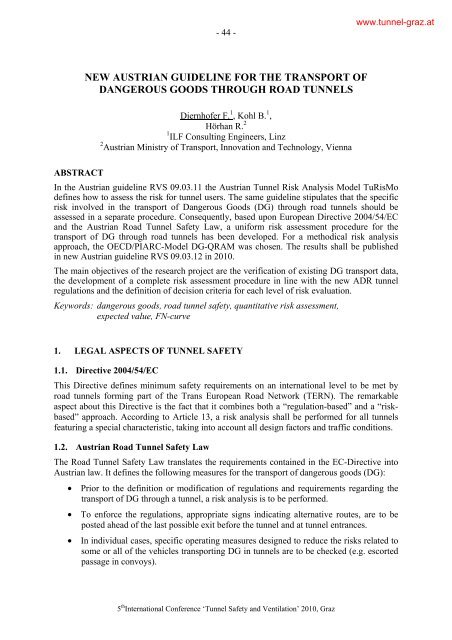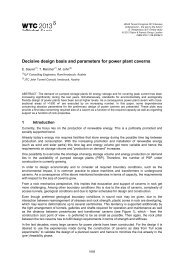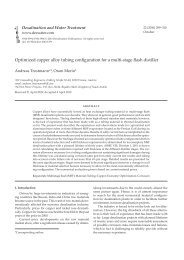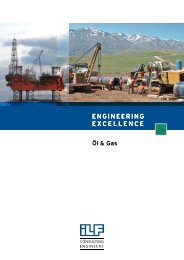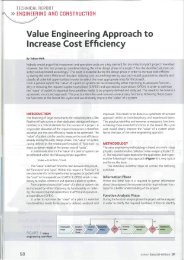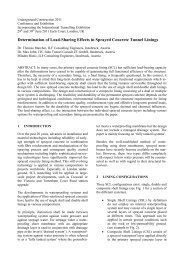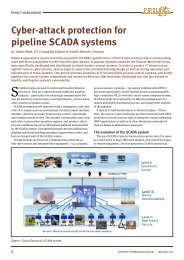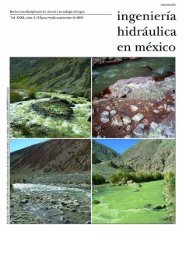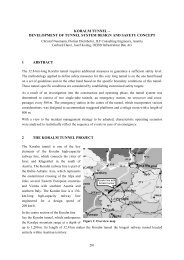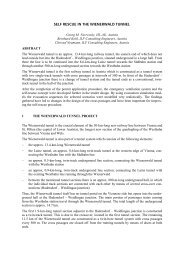New austrian guideline for the transport of - ILF Consulting Engineers
New austrian guideline for the transport of - ILF Consulting Engineers
New austrian guideline for the transport of - ILF Consulting Engineers
You also want an ePaper? Increase the reach of your titles
YUMPU automatically turns print PDFs into web optimized ePapers that Google loves.
- 44 -<br />
NEW AUSTRIAN GUIDELINE FOR THE TRANSPORT OF<br />
DANGEROUS GOODS THROUGH ROAD TUNNELS<br />
Diernh<strong>of</strong>er F. 1 , Kohl B. 1 ,<br />
Hörhan R. 2<br />
1 <strong>ILF</strong> <strong>Consulting</strong> <strong>Engineers</strong>, Linz<br />
2 Austrian Ministry <strong>of</strong> Transport, Innovation and Technology, Vienna<br />
ABSTRACT<br />
In <strong>the</strong> Austrian <strong>guideline</strong> RVS 09.03.11 <strong>the</strong> Austrian Tunnel Risk Analysis Model TuRisMo<br />
defines how to assess <strong>the</strong> risk <strong>for</strong> tunnel users. The same <strong>guideline</strong> stipulates that <strong>the</strong> specific<br />
risk involved in <strong>the</strong> <strong>transport</strong> <strong>of</strong> Dangerous Goods (DG) through road tunnels should be<br />
assessed in a separate procedure. Consequently, based upon European Directive 2004/54/EC<br />
and <strong>the</strong> Austrian Road Tunnel Safety Law, a uni<strong>for</strong>m risk assessment procedure <strong>for</strong> <strong>the</strong><br />
<strong>transport</strong> <strong>of</strong> DG through road tunnels has been developed. For a methodical risk analysis<br />
approach, <strong>the</strong> OECD/PIARC-Model DG-QRAM was chosen. The results shall be published<br />
in new Austrian <strong>guideline</strong> RVS 09.03.12 in 2010.<br />
The main objectives <strong>of</strong> <strong>the</strong> research project are <strong>the</strong> verification <strong>of</strong> existing DG <strong>transport</strong> data,<br />
<strong>the</strong> development <strong>of</strong> a complete risk assessment procedure in line with <strong>the</strong> new ADR tunnel<br />
regulations and <strong>the</strong> definition <strong>of</strong> decision criteria <strong>for</strong> each level <strong>of</strong> risk evaluation.<br />
Keywords: dangerous goods, road tunnel safety, quantitative risk assessment,<br />
expected value, FN-curve<br />
1. LEGAL ASPECTS OF TUNNEL SAFETY<br />
1.1. Directive 2004/54/EC<br />
This Directive defines minimum safety requirements on an international level to be met by<br />
road tunnels <strong>for</strong>ming part <strong>of</strong> <strong>the</strong> Trans European Road Network (TERN). The remarkable<br />
aspect about this Directive is <strong>the</strong> fact that it combines both a “regulation-based” and a “riskbased”<br />
approach. According to Article 13, a risk analysis shall be per<strong>for</strong>med <strong>for</strong> all tunnels<br />
featuring a special characteristic, taking into account all design factors and traffic conditions.<br />
1.2. Austrian Road Tunnel Safety Law<br />
The Road Tunnel Safety Law translates <strong>the</strong> requirements contained in <strong>the</strong> EC-Directive into<br />
Austrian law. It defines <strong>the</strong> following measures <strong>for</strong> <strong>the</strong> <strong>transport</strong> <strong>of</strong> dangerous goods (DG):<br />
• Prior to <strong>the</strong> definition or modification <strong>of</strong> regulations and requirements regarding <strong>the</strong><br />
<strong>transport</strong> <strong>of</strong> DG through a tunnel, a risk analysis is to be per<strong>for</strong>med.<br />
• To en<strong>for</strong>ce <strong>the</strong> regulations, appropriate signs indicating alternative routes, are to be<br />
posted ahead <strong>of</strong> <strong>the</strong> last possible exit be<strong>for</strong>e <strong>the</strong> tunnel and at tunnel entrances.<br />
• In individual cases, specific operating measures designed to reduce <strong>the</strong> risks related to<br />
some or all <strong>of</strong> <strong>the</strong> vehicles <strong>transport</strong>ing DG in tunnels are to be checked (e.g. escorted<br />
passage in convoys).<br />
5 th International Conference ‘Tunnel Safety and Ventilation’ 2010, Graz
- 45 -<br />
1.3. ADR 2007 / 2009<br />
When <strong>the</strong> European Agreement concerning <strong>the</strong> International Carriage <strong>of</strong> Dangerous Goods by<br />
Road, commonly known as ADR was revised in 2007, so called tunnel restriction codes were<br />
assigned to all dangerous substances according to <strong>the</strong>ir potential <strong>of</strong> damage, amount (mass)<br />
and carriage type. These codes serve as a basis <strong>for</strong> a uni<strong>for</strong>m European regulation governing<br />
<strong>the</strong> <strong>transport</strong> <strong>of</strong> dangerous goods though road tunnels.<br />
To en<strong>for</strong>ce restrictions <strong>of</strong> DG <strong>transport</strong>ing vehicles through a tunnel <strong>the</strong> relevant authorities<br />
shall assign <strong>the</strong> tunnel to a category defined in <strong>the</strong> ADR (Table 1). The new tunnel<br />
regulations <strong>of</strong> <strong>the</strong> ADR have been valid since <strong>the</strong> 1 st <strong>of</strong> January 2010.<br />
Table 1: ADR tunnel categories and signature<br />
Tunnel categories Restrictions Sign Traffic Sign<br />
A No restrictions <strong>for</strong> <strong>the</strong> <strong>transport</strong> <strong>of</strong> dangerous<br />
goods<br />
B Restriction <strong>for</strong> dangerous goods which may lead<br />
to a very large explosion<br />
C Restriction <strong>for</strong> dangerous goods which may lead<br />
to a very large explosion, a large explosion or<br />
a large toxic release<br />
D Restriction <strong>for</strong> dangerous goods which may lead<br />
to a very large explosion, to a large explosion,<br />
to a large toxic release or to a large fire<br />
E Restriction <strong>for</strong> all dangerous goods o<strong>the</strong>r than<br />
UN Nos. 2919, 3291, 3331, 3359 and 3373<br />
No sign -<br />
Sign with additional panel<br />
bearing <strong>the</strong> letter B<br />
Sign with additional panel<br />
bearing <strong>the</strong> letter C<br />
Sign with additional panel<br />
bearing <strong>the</strong> letter D<br />
Sign with additional panel<br />
bearing <strong>the</strong> letter E<br />
2. DATA BASE<br />
At <strong>the</strong> beginning <strong>of</strong> <strong>the</strong> research project great emphasis was put on <strong>the</strong> data base. From 2006<br />
to 2007 investigations <strong>of</strong> DG <strong>transport</strong>s were carried out at 12 different cross sections on<br />
Austria’s main traffic routes. In March 2009, <strong>the</strong> results <strong>of</strong> <strong>the</strong>se earlier investigations were<br />
evaluated and expanded by a detailed review <strong>of</strong> DG <strong>transport</strong>s in cooperation with <strong>the</strong> police.<br />
For one month (March 2009) <strong>the</strong> police stopped DG vehicles and controlled <strong>the</strong>ir <strong>transport</strong><br />
documents. The investigation was accomplished in all Austrian federal states and assigned<br />
detailed in<strong>for</strong>mation about <strong>the</strong> UN number, amount, carriage type and destination <strong>of</strong> <strong>the</strong><br />
dangerous substances.<br />
The applied risk model includes <strong>for</strong> <strong>the</strong> most part very “severe” scenarios with huge amounts<br />
<strong>of</strong> dangerous substances involved. For example scenario 4 stands <strong>for</strong> a pool fire <strong>of</strong> a 28 ton<br />
tank <strong>of</strong> diesel/petrol. Using <strong>the</strong> model scenarios without an adjustment would lead to an<br />
overestimation <strong>of</strong> risks. For that matter <strong>the</strong> data collected in <strong>the</strong> detailed investigation were<br />
used to define more realistic allocation rules (see example in Figure 1).<br />
5 th International Conference ‘Tunnel Safety and Ventilation’ 2010, Graz
TANK<br />
- 46 -<br />
FULL EMPTY<br />
ADR-Class 2<br />
Dangerc. 23:<br />
> 0 kg Dangerc. 20/22: > 0 kg<br />
Dangercode 23:<br />
Dangerc. 25/225: 0 kg<br />
Dangercode 23:<br />
> 0 kg<br />
Dangercode 20/22:<br />
Dangercode 25/225:<br />
Dangerc. 25/225: Dangerc. 20/22:<br />
Sc. 7, 8, 9 Sc. 13 no Sc. Sc. 3 Sc. 13<br />
5 th International Conference ‘Tunnel Safety and Ventilation’ 2010, Graz<br />
PACKEGED / MIXED CARGO<br />
Figure 1: Allocation key <strong>for</strong> flammable gases (ADR class 2)<br />
In addition, <strong>the</strong> results <strong>of</strong> <strong>the</strong> investigations revealed that in Austria <strong>the</strong> composition <strong>of</strong> <strong>the</strong><br />
DG carriage varies only slightly on different traffic routes and that <strong>the</strong>se variations have only<br />
little influence on <strong>the</strong> risk faced by tunnel users. Eventually, a standardized, averaged scenario<br />
allocation <strong>for</strong> Austria based upon a detailed DG investigation was found (Table 2).<br />
Table 2: Standardized scenario allocation <strong>for</strong> Austria (DG-QRAM)<br />
Accident scenarios - DG-QRAM Proportion<br />
Scenario 3: BLEVE <strong>of</strong> flammable gases in 50kg-cylinder (e.g. Propane) 0,0226<br />
Scenario 4: pool fire <strong>of</strong> flammable liquids in bulk (e.g. Petrol, Diesel) 0,4270<br />
Szenario 5: VCE <strong>of</strong> flammable liquids in bulk which may lead to explosive air<br />
fuel mixture (e.g. Petrol), assigned as fraction <strong>of</strong> scenario 4 0,3610<br />
Scenario 6: release <strong>of</strong> very toxic gases in bulk (e.g. Chloride) 0,0010<br />
Scenario 7 / 8 / 9: BLEVE / VCE <strong>of</strong> flammable gases in bulk (e.g. Propane) 0,0113<br />
Scenario 10: release <strong>of</strong> toxic gases in bulk (e.g. Ammonia) 0,0010<br />
Scenario 11: release <strong>of</strong> toxic fluids in bulk (e.g. Acrolein) 0,0133<br />
Scenario 12: release <strong>of</strong> toxic fluids in 100kg-cylinder (e.g. Acrolein) 0,0113<br />
Scenario 13: burst <strong>of</strong> a tank <strong>of</strong> non flammable gases (e.g. liquefied refrigerated CO2) 0,0452<br />
3. OECD/PIARC MODEL (DG-QRAM)<br />
To calculate <strong>the</strong> risks involved in <strong>transport</strong>ing DG an international accepted risk analysis<br />
model called DG-QRAM is applied. The risk model was developed on behalf <strong>of</strong><br />
OECD/PIARC and is widely used on an international basis, but is obviously not <strong>the</strong> only<br />
method available <strong>for</strong> assessing <strong>the</strong> risk resulting from <strong>the</strong> <strong>transport</strong> <strong>of</strong> DG.<br />
The results <strong>of</strong> <strong>the</strong> risk analysis model are depicted as Expected Values (EV) or F-N curves,<br />
illustrating <strong>the</strong> relation between accident frequency (F) and accident consequences (N number<br />
<strong>of</strong> fatalities). Whereas <strong>the</strong> EV represents <strong>the</strong> average expected number <strong>of</strong> fatalities as a result<br />
<strong>of</strong> all DG accidents, <strong>the</strong> F-N curve gives more comprehensive in<strong>for</strong>mation on <strong>the</strong> extent <strong>of</strong><br />
damage in relation to <strong>the</strong> probability <strong>of</strong> individual accidents (Figure 3).<br />
> 0 kg
- 47 -<br />
4. DEVELOPMENT OF A COMPLETE RISK ASSESSMENT PROCEDURE<br />
In <strong>the</strong> year 2009, <strong>the</strong> Austrian Federal Ministry <strong>for</strong> Transport, Innovation and Technology<br />
(BMVIT) launched a research project with <strong>the</strong> objective <strong>of</strong> establishing a complete<br />
investigation and assessment procedure concerning risk analyses <strong>for</strong> DG (using DG-QRAM).<br />
The research project was exclusively focused on assessing <strong>the</strong> risk <strong>of</strong> DG accidents, whereas<br />
mechanical accidents and conventional fires are addressed by <strong>the</strong> risk model TuRisMo. The<br />
final results have been presented in a new Austrian <strong>guideline</strong> (draft). The finalized version<br />
should be published in 2010.<br />
The research project served <strong>the</strong> purpose <strong>of</strong> defining a clearly structured risk assessment<br />
procedure in line with <strong>the</strong> new ADR tunnel regulations, based upon reliable DG data. In <strong>the</strong><br />
course <strong>of</strong> this project, risk reference criteria <strong>for</strong> every step <strong>of</strong> <strong>the</strong> assessment procedure had to<br />
be laid down. The project was supported by a work group comprising technical and legal<br />
experts <strong>of</strong> <strong>the</strong> BMVIT and <strong>the</strong> Austrian Ministry <strong>of</strong> Internal Affairs, <strong>the</strong> Austrian federal<br />
provinces, <strong>the</strong> Austrian Chamber <strong>of</strong> Commerce, <strong>the</strong> ASFINAG, <strong>the</strong> fire brigade, <strong>the</strong> <strong>transport</strong><br />
industry as well as <strong>ILF</strong> <strong>Consulting</strong> <strong>Engineers</strong>.<br />
In principle, <strong>the</strong> risk involved in <strong>the</strong> <strong>transport</strong> <strong>of</strong> DG is determined in a multi-stage assessment<br />
procedure.<br />
4.1. Stage 1 – Classification Matrix<br />
Stage 1 involves using a simple classification matrix (Figure 2) to define DG risks <strong>of</strong> road<br />
tunnels. The application <strong>of</strong> <strong>the</strong> matrix shall permit a simple identification <strong>of</strong> tunnels with a<br />
low DG <strong>transport</strong> risk.<br />
The classification matrix takes into account <strong>the</strong> following main risk factors:<br />
• <strong>the</strong> tunnel length<br />
• <strong>the</strong> type <strong>of</strong> tunnel (bi-directional or uni-directional traffic)<br />
• <strong>the</strong> ventilation system (natural, longitudinal or transverse)<br />
• <strong>the</strong> traffic volume<br />
• <strong>the</strong> percentage <strong>of</strong> heavy goods vehicles (HGV)<br />
The respective parameters <strong>of</strong> <strong>the</strong> matrix were defined in a <strong>for</strong>mer study per<strong>for</strong>med in 2008.<br />
Then, a systematically risk calculation were per<strong>for</strong>med <strong>for</strong> a set <strong>of</strong> selected reference tunnels<br />
using DG-QRAM. As decision criteria an expected risk value <strong>of</strong> EV = 1 x 10 -3 fatalities/year<br />
was applied <strong>for</strong> <strong>the</strong> elaboration <strong>of</strong> <strong>the</strong> matrix.<br />
If a tunnel is assigned to a dark field <strong>of</strong> <strong>the</strong> matrix, a risk analysis has to be per<strong>for</strong>med.<br />
A first examination <strong>of</strong> <strong>the</strong> Austrian road tunnels revealed, that approximately half <strong>of</strong> <strong>the</strong><br />
tunnels require no fur<strong>the</strong>r risk investigation. These tunnels could, in line with <strong>the</strong> ADR,<br />
directly be allocated to tunnel category A.<br />
The application <strong>of</strong> <strong>the</strong> matrix is only admissible, if a set <strong>of</strong> requirements is fulfilled (e.g.<br />
proportion <strong>of</strong> heavy goods vehicles ≤ 25%, longitudinal gradient ≤ 3%, no extraordinary<br />
proportion <strong>of</strong> DG, etc.).<br />
5 th International Conference ‘Tunnel Safety and Ventilation’ 2010, Graz
type <strong>of</strong><br />
traffic<br />
uni<br />
directional<br />
bi<br />
directional<br />
ventialtion<br />
system<br />
HGV [%]<br />
tunnel length<br />
[m]<br />
- 48 -<br />
daily average traffic volume [veh/day]<br />
≤ 10000 ≤ 15000 ≤ 20000 ≤ 30000 ≤40000<br />
≤ 10 ≤ 15 ≤ 20 ≤ 25 ≤ 5 ≤ 10 ≤ 15 ≤ 20 ≤ 25 ≤ 5 ≤ 10 ≤ 15 ≤ 20 ≤ 25 ≤ 5 ≤ 10 ≤ 15 ≤ 20 ≤ 25 ≤ 5 ≤ 10 > 10<br />
natural ≤ 250 5,62E-04 7,52E-04 9,17E-04 1,10 E- 0 3<br />
natural ≤ 500 1,00E-05 6,96E-04 9,17E-04 1,31E-03 1,70E-03 5,51E-03 9,34E-04 1,81E-03 1,81E-03<br />
longitudinal ≤ 700 4,10E-05 1,97E-04 9,29E-05 2,50E-04 2,73E-04 3,00E-04 4,44E-04 2,18E-04 5,00E-04 6,38E-04 8,21E-04 1,22E-03 6,31E-04 1,22E-03 1,22E-03 1,22E-03 3,00E-03 1,02E-03 1,02E-03 1,02E-03<br />
longitudinal ≤ 1000 1,00E-04 1,00E-04 1,00E-04 1,00E-04 1,00E-04 1,00E-04 1,00E-04 1,00E-04 1,00E-04 6,00E-04 1,06E-03 2,66E-03 8,00E-04 1,50 E- 0 3 1,50 E-0 3 1,50 E- 0 3 1,50 E- 0 3 1,0 0 E- 0 2 1,0 1E+0 0 1,0 1E+0 0<br />
longitudinal ≤ 1500 6,76E-05 3,26E-04 1,54E-04 5,00E-04 4,52E-04 6,00E-04 7,38E-04 3,62E-04 7,17E-04 8,92E-04 1,38E-03 1,43E-03 1,35E-03 5,15E-03 1,04E-02 1,43E-03 1,04E-02 2,19E-03 2,19E-03 2,19E-03<br />
longitudinal ≤ 2000 1,00E-04 1,00E-04 1,00E-04 1,00E-04 1,00E-04 1,00E-04 1,00E-04 1,00E-04 8,71E-04 1,31E-03 1,38E-03 2,72E-03 1,33E-03 1,00E-02 1,00E-02 1,00E-02 1,00E-02 1,00E-02 1,00E-02 1,00E-02<br />
longitudinal ≤ 2500 1,00E-04 1,00E-04 1,00E-04 1,00E-04 1,00E-04 1,00E-04 1,00E-04 1,00E-04 1,09E-03 1,00E+00 1,38E-03 2,75E-03 1,65E-03 1,00E-02 1,00E-02 1,00E-02 1,00E-02 1,00E-02 1,00E-02 1,00E-02<br />
longitudinal ≤ 3000 1,06E-04 5,12E-04 2,42E-04 6,00E-04 5,00E-04 4,00E-04 5,12E-04 5,69E-04 1,13E-03 1,69E-03 1,00E-01 2,72E-03 1,73E-03 8,14E-03 9,30E-03 2,72E-03 9,30E-03 3,54E-03 1,54E-03 2,60E-03<br />
transverse ≤ 4000 1,00E-04 1,00E-04 1,00E-04 1,00E-04 1,00E-04 8,12E-04 8,98E-04 1,00E-04 1,76E-03 1,80E-03 1,00E-02 1,00E-02 1,00E-02 1,00E-02 1,00E-02 1,00E-02 1,01E+00 1,00E-02 1,01E+00 1,01E+00<br />
transverse ≤ 7000 1,95E-04 8,43E-04 3,46E-04 7,00E-04 9,28E-04 1,19 E- 0 3 1,2 9 E- 0 3 2,05E-04 1,27E-03 1,80E-03 2,27E-03 2,75E-03 1,51E-03 6,14E-03 1,04E-02 2,75E-03 1,04E-02 2,54E-03 1,08E-03 1,41E-03<br />
natural ≤ 250 # ## # # ## # ## # ## # # # # ## # ## # ## 7,00E-04 9,74E-04 # ## # # 6,76E-04 5,23E-04 # ## # # 6,16E-04 7,70E-04 9,17E-04 5,99E-04 0,00E+00 1,00E-02<br />
natural ≤ 500 1,95E-04 8,43E-04 3,46E-04 7,00E-04 9,28E-04 7,00E-04 9,74E-04 2,05E-04 6,76E-04 1,04E-03 1,27E-03 7,42E-04 1,13E-03 2,75E-03 2,75E-03 6,14E-03 8,90E-04 1,00E-02 1,00E-02<br />
natural ≤ 700 1,00E-05 5,00E-05 5,00E-04 5,00E-04 5,62E-04 7,00E-04 9,74E-04 3,55E-04 6,76E-04 1,17E-03 1,30E-03 1,65E-03 7,42E-04 5,00E-03 1,65E-03 1,65E-03 5,00E-03 1,00E-02 1,00E-02 1,00E-02<br />
natural ≤ 1000 3,52E-04 1,14 E- 0 3 1,3 9 E- 0 3 6,00E-04 1,19E-03 1,00E-02 1,00E-02 1,20E-03 1,30E-03 1,00E-02 1,00E-02 1,00E-02 1,01E+00 1,00E-02 1,00E-02 1,00E-02<br />
longitudinal ≤ 1500 8,22E-05 3,87E-04 4,37E-04 8,55E-04 1,12 E- 0 3 1,75E- 0 3 2 ,10 E- 0 3 9,71E-04 1,72E-03 2,57E-03 1,00E-01 4,17E-03 1,94E-03 8,65E-03 4,17E-03 4,17E-03 8,65E-03 1,00E-02 1,00E-02 1,00E-02<br />
longitudinal ≤ 2000 1,24E-03 1,00E-02 1,00E-02 1,00E-02 1,22E-03 1,00E-01 1,00E-01 1,00E-01 1,00E-01 1,00E-01 1,00E-01 1,00E-01 1,00E-01 1,10E+00 1,00E-02 1,00E-02 1,00E-02<br />
longitudinal ≤ 2500 7,46E-04 1,45E-03 3,00E-03 1,50E-03 5,00E-03 1,50E-03 1,50E-03 1,50E-03 1,00E-01 7,00E-03 5,00E-03 9,50E-03 7,00E-03 7,00E-03 9,50E-03 1,00E-02 1,00E-02 1,00E-02<br />
longitudinal ≤ 3000 9,82E-04 1,01E-03 1,00E-01 1,00E-01 1,00E-01 1,00E-01 1,00E-01 1,00E-01 1,00E-01 1,00E-01 1,00E-01 1,00E-01 1,00E-01 1,00E-01 1,00E-01 1,00E-01 1,00E-02 1,00E-02 1,00E-02<br />
transverse ≤ 3000 ##### 1,00E-01 1,00E-01 1,00E-01 1,00E-01 1,00E-01 1,00E-01 1,00E-01 1,00E-01 1,00E-01 1,00E-01 1,00E-01 1,00E-01 1,00E-01 1,00E-01 1,00E-02 1,00E-02 1,00E-02<br />
transverse ≤ 4000 8,31E-04 1,01E-03 1,00E-01 1,00E-01 1,00E-01 1,00E-01 1,00E-01 1,00E-01 1,00E-01 1,00E-01 1,00E-01 1,00E-01 1,00E-01 1,00E-01 1,00E-01 1,00E-01 1,00E-01 1,00E-02 1,00E-02 1,00E-02<br />
transverse ≤ 7000 7,62E-04 1,13E-03 1,49E-03 1,85E-03 2,07E-03 2,07E-03 6,15E-03 1,24E-02 9,80E-03 4,16E-03 7,50E-03 1,24E-02 1,00E-01 1,97E-02 8,73E-03 4,03E-02 1,97E-02 1,97E-02 4,03E-02 1,00E-02 1,00E-02 1,00E-02<br />
Figure 2: Classification matrix (stage 1)<br />
4.2. Stage 2 – Detailed Approach<br />
All those tunnels which indicate a relevant DG risk in stage 1 are subsequently reviewed in a<br />
detailed, tunnel-specific risk analysis using DG-QRAM (Stage 2a).<br />
Whereas <strong>the</strong> decision criterion in stage 1 is based upon <strong>the</strong> expected value, in stage 2 <strong>the</strong><br />
assessment is assigned to <strong>the</strong> log scaled F-N diagram. The results (scenario-based FN-curves)<br />
are evaluated by comparing <strong>the</strong>m to a defined reference line in <strong>the</strong> F-N diagram (see example<br />
in Figure 3). If <strong>the</strong> reference line is exceeded, additional risk reducing measures are to be<br />
investigated (Stage 2b).<br />
F cummulated frequency [1/ tunnel, year]<br />
1,E+00<br />
1,E-01<br />
1,E-02<br />
1,E-03<br />
1,E-04<br />
1,E-05<br />
1,E-06<br />
1,E-07<br />
1,E-08<br />
Uni-directional tunnel; length = 1,000m; 55,000 veh/day; HGV 20%; DG 3%<br />
All Scenarios - EV = 2,870E-2<br />
Scenario 4: Motor spirit pool fire<br />
Scenario 5 : VCE <strong>of</strong> motor spirit<br />
Scenario 7: BLEVE <strong>of</strong> LPG in bulk<br />
Scenario 8: VCE <strong>of</strong> LPG in bulk<br />
Scenario 9: Torch fire <strong>of</strong> LPG in bulk<br />
reference line <strong>for</strong> risk assessment<br />
1 10 100<br />
N number <strong>of</strong> fatalities<br />
1000 10000<br />
Figure 3: Reference line as assessment criterion in <strong>the</strong> F-N diagram (stage 2a)<br />
5 th International Conference ‘Tunnel Safety and Ventilation’ 2010, Graz
- 49 -<br />
4.3. Stage 3 – Alternative Route<br />
Generally, <strong>the</strong> <strong>transport</strong> <strong>of</strong> DG on <strong>the</strong> road is not restricted as long as <strong>the</strong> requirements <strong>of</strong> <strong>the</strong><br />
ADR are met. If <strong>the</strong> assessment procedure determines that <strong>the</strong> investigated tunnel possesses<br />
an intolerably high risk, restrictions to <strong>the</strong> DG <strong>transport</strong> <strong>for</strong> a tunnel are to be examined. In<br />
this case <strong>the</strong> existence <strong>of</strong> an adequate alternative route is investigated. A road only qualifies as<br />
an alternative route if <strong>the</strong> entire road segment is suitable and approved <strong>for</strong> heavy goods traffic.<br />
This requires such aspects as: <strong>the</strong> number <strong>of</strong> lanes, <strong>the</strong> longitudinal gradient, <strong>the</strong> road width,<br />
curve radii, etc. (be reviewed on a case-to-case basis).<br />
The examination <strong>of</strong> <strong>the</strong> alternative route follows <strong>the</strong> principle that a generally allowed,<br />
existing <strong>transport</strong> volume <strong>of</strong> DG should be carried on that route which shows <strong>the</strong> slightest<br />
<strong>transport</strong> risk. There<strong>for</strong>e, it must be shown that <strong>the</strong> risk <strong>of</strong> <strong>transport</strong>ing DG on <strong>the</strong> alternative<br />
route is significantly lower <strong>for</strong> <strong>the</strong> resident population than <strong>the</strong> risk <strong>of</strong> unrestricted <strong>transport</strong><br />
through <strong>the</strong> tunnel <strong>for</strong> <strong>the</strong> tunnel users.<br />
The risk calculations <strong>for</strong> <strong>the</strong> alternative routes (open road sections) are also per<strong>for</strong>med by<br />
application <strong>of</strong> <strong>the</strong> risk analysis model DG QRAM.<br />
2 km<br />
City<br />
Highway<br />
Tunnelroute<br />
Alternative 2<br />
Investigation area<br />
Alternative 1<br />
Tunnel<br />
Village 1<br />
Investigation area<br />
Alternative 2<br />
Alternative 1<br />
Figure 4: Alternative route (stage 3)<br />
City<br />
Village 2<br />
5 th International Conference ‘Tunnel Safety and Ventilation’ 2010, Graz
- 50 -<br />
5. MEASURES<br />
If in stage 2a <strong>the</strong> reference criterion in <strong>the</strong> F-N diagram is exceeded, <strong>the</strong> DG risk is rated as<br />
unacceptable and special additional risk reduction measures needs to be investigated (Stage<br />
2b).<br />
Consideration made to improve traffic safety predominantly focuses on organisational and<br />
operational measures. In this context, it should be noted that not every measure is equally<br />
suited or efficient. The envisioned measures will thus have to be checked individually <strong>for</strong> <strong>the</strong><br />
respective tunnel system in an in-depth risk analysis.<br />
The current regulation <strong>for</strong> highways BGBl. 395/2001 issued by <strong>the</strong> Federal Ministry <strong>for</strong><br />
Transport, Innovation and Technology (BMVIT) already stipulates operational measures<br />
depending on tunnel length:<br />
• Tunnels with a length between 1,000 m and < 5,000 m require a flashing warning light<br />
on <strong>the</strong> vehicle.<br />
• Tunnels with a length <strong>of</strong> > 5,000 m require a flashing warning light, an escort vehicle<br />
following <strong>the</strong> <strong>transport</strong> unit and <strong>the</strong> distribution <strong>of</strong> <strong>transport</strong> documents to <strong>the</strong><br />
personnel <strong>of</strong> <strong>the</strong> escort vehicle.<br />
Additional operational measures aimed at reducing <strong>the</strong> <strong>transport</strong> risk <strong>of</strong> DG may include:<br />
• Introduction <strong>of</strong> an overtaking ban<br />
• Introduction <strong>of</strong> a speed limit<br />
• Installation <strong>of</strong> an in<strong>for</strong>mation system<br />
• Installation <strong>of</strong> a speed control system<br />
6. DEFINITION OF RISK CRITERIA<br />
As mentioned earlier, <strong>the</strong> societal risk is usually expressed in a graph (F-N diagram). To<br />
determine whe<strong>the</strong>r <strong>the</strong> safety level is acceptable or not, an assessment <strong>of</strong> <strong>the</strong> societal risk can<br />
be made. This is based upon a risk reference criterion which is <strong>of</strong>ten determined specifically<br />
<strong>for</strong> <strong>the</strong> project in question.<br />
For example, an <strong>of</strong>ficially established risk limit line concerning DG is used in Switzerland (in<br />
<strong>the</strong> Swiss Accidents Ordinance).<br />
6.1. Reference line <strong>for</strong> risk assessment<br />
In <strong>the</strong> detailed analysis (stage 2), <strong>the</strong> assessment is based upon a defined assessment criterion<br />
in <strong>the</strong> F-N diagram. This reference line was calculated by <strong>the</strong> following <strong>for</strong>mula:<br />
−1<br />
10<br />
For N ≥ 10 fatalities: F = ... <strong>for</strong> 1 km <strong>of</strong> tunnel (1)<br />
2<br />
N<br />
The slope <strong>of</strong> <strong>the</strong> equation reflects <strong>the</strong> risk aversion level. If <strong>the</strong> number <strong>of</strong> fatalities increases<br />
by a factor <strong>of</strong> 10, <strong>the</strong> acceptable occurrence frequency decreases by a factor <strong>of</strong> 100.<br />
The reference line was defined taking into account several aspects:<br />
• risk level in comparable reference systems (e.g. aviation)<br />
• reference criteria used in o<strong>the</strong>r countries (e.g. Switzerland, Ne<strong>the</strong>rlands)<br />
• special model characteristics <strong>of</strong> DG-QRAM (e.g. adjustment <strong>for</strong> length)<br />
5 th International Conference ‘Tunnel Safety and Ventilation’ 2010, Graz
- 51 -<br />
6.2. Adjustment <strong>of</strong> <strong>the</strong> reference line <strong>for</strong> tunnel length<br />
A risk assessment based upon <strong>the</strong> defined reference line requires a standardized tunnel length,<br />
as <strong>the</strong> reference criterion (1) is usually based on 1 km. For <strong>the</strong> assessment criterion to be used<br />
in <strong>the</strong> F-N diagram, an adjustment <strong>for</strong> <strong>the</strong> length <strong>of</strong> <strong>the</strong> tunnel had to be made.<br />
Concerning <strong>the</strong> tunnel safety topic, <strong>the</strong> length <strong>of</strong> <strong>the</strong> tunnel is an especially critical factor.<br />
There<strong>for</strong>e, <strong>the</strong> adjustment should not be linear to <strong>the</strong> length <strong>of</strong> <strong>the</strong> tunnel. Hence, <strong>the</strong><br />
relationship between tunnel length and risk was modelled as an exponential function:<br />
−1<br />
10 0.<br />
5<br />
For N ≥ 10 fatalities:<br />
F = × L ... L = tunnel length [km] (2)<br />
2<br />
N<br />
To evaluate <strong>the</strong> reference criterion (2) <strong>transport</strong> risks <strong>of</strong> several common road tunnels in<br />
Austria were calculated and assessed in <strong>the</strong> F-N diagram.<br />
7. INTERNATIONAL OUTLOOK<br />
The ADR’s tunnel regulations have been valid since <strong>the</strong> 1 st <strong>of</strong> January 2010. Although <strong>the</strong><br />
European countries have already assigned many tunnels with restrictions to ADR’s tunnel<br />
categories, this implementation process isn’t completely accomplished. The network-wide<br />
risk assessment and <strong>the</strong> assignment to risk categories will take some time to be finalized;<br />
especially <strong>for</strong> states with a great number <strong>of</strong> road tunnels.<br />
Thus current development trends in <strong>the</strong> <strong>transport</strong> industry ought to be observed and taken into<br />
account. The <strong>transport</strong> industry is likely to face certain additional costs <strong>for</strong> <strong>the</strong> <strong>transport</strong> <strong>of</strong><br />
DG as alternative routes tend to result in longer <strong>transport</strong> times and longer carriage distances.<br />
8. REFERENCE LIST<br />
Directive 2004/54/EC <strong>of</strong> <strong>the</strong> European Parliament and <strong>of</strong> <strong>the</strong> Council <strong>of</strong> 29 April on minimum<br />
safety requirements <strong>for</strong> tunnels in <strong>the</strong> Trans-European Road Network<br />
Bundesgesetz über die Sicherheit von Straßentunneln (Straßentunnelsicherheitsgesetz STSG),<br />
BGBL 54/2006, Österreichischer Nationalrat, 2006<br />
ADR 2007 European Agreement concerning <strong>the</strong> International Carriage <strong>of</strong> Dangerous Goods<br />
by Road, United Nations 2006<br />
Beschränkungen für Beförderungseinheiten mit gefährlichen Gütern beim Befahren von<br />
Autobahntunneln, BGBl. II Nummer 395/2001, Verordnung des BMVIT für Autobahnen<br />
Schweizer Störfallverordnung StFV (Swiss Accidents Ordinance), EDMZ, 1991<br />
Transport <strong>of</strong> Dangerous Goods through road tunnels – Quantitative Risk Assessment Model,<br />
OECD/PIARC/EU, 2003<br />
RVS 09.03.11 Tunnel Safety - Tunnel Risk Model, FSV (Österreichische Forschungsgesellschaft<br />
Straße – Schiene - Verkehr), 2008<br />
RVS 09.03.12 Tunnel Safety – Risk Assessment <strong>of</strong> Dangerous Goods Tansports in Road<br />
Tunnels (draft), FSV (Österreichische Forschungsgesellschaft Straße – Schiene - Verkehr),<br />
2008<br />
5 th International Conference ‘Tunnel Safety and Ventilation’ 2010, Graz


